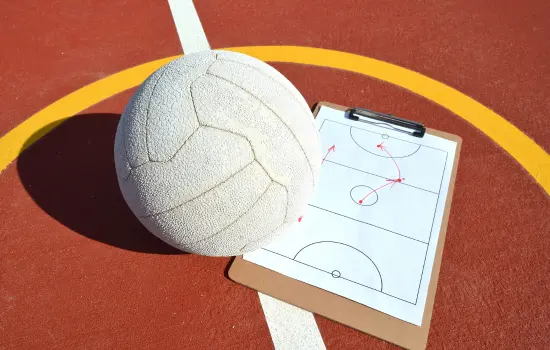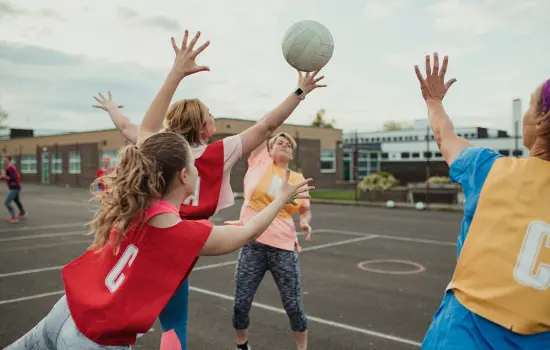What is Netball?
The History of Netball
1. Origin in the Late 19th Century
2. Early Evolution of the Game
3. Global Expansion
4. Inclusion in the Commonwealth Games
5. Modern Growth

How is Netball Played?
Objective of Netball
Team Structure and Player Positions
| Position | Abbreviation | Role Description |
|---|---|---|
| Goal Shooter | GS | Responsible for scoring goals. |
| Goal Attack | GA | Supports GS and can also shoot. |
| Wing Attack | WA | Moves the ball to the attacking circle. |
| Centre | C | Links defense and attack. |
| Wing Defense | WD | Marks the opposing WA. |
| Goal Defense | GD | Protects the goal circle. |
| Goal Keeper | GK | Guards the hoop directly. |
Key Features of the Netball Court
| Court Zone | Player Access |
|---|---|
| Defensive Third | GK, GD, WD |
| Center Third | All except GS and GK |
| Attacking Third | GS, GA, WA, and C |
Equipment Used
- Netball: Slightly smaller and lighter than a basketball.
- Goalposts: Positioned at each end of the court.
Important Rules
- Players have 3 seconds to pass the ball.
- No dribbling is allowed.
- Players must stay in their designated areas.
Rules of Netball
Core Rules
Positional Restrictions and Movement
- Goal Shooter (GS): Restricted to the attacking third and goal circle for shooting.
- Goal Attack (GA): Allowed in the attacking third, center third, and goal circle to support GS and score.
- Wing Attack (WA): Operates in the attacking third and center third but cannot enter the goal circle.
- Centre (C): Moves across all thirds except the goal circles, linking defense and attack.
- Wing Defense (WD): Limited to the center third and defensive third, excluding the goal circle.
- Goal Defense (GD): Plays in the defensive third, center third, and goal circle to prevent scoring.
- Goal Keeper (GK): Stays in the defensive third and goal circle to block shots and rebounds.
Contact and Obstruction Rules
Types of Netball Games
1. Traditional Netball
- Team Structure: Each team consists of seven players, each with a fixed position and designated area on the court. Players’ movement is restricted to their specific zones, ensuring strategy and teamwork.
- Game Duration: Matches are played in four quarters, each lasting 15 minutes, with breaks in between. This format allows for consistent pacing and strategic planning during breaks.
- Key Features:
- Strict adherence to positional roles, such as GS (Goal Shooter) and GK (Goal Keeper).
- A focus on skillful passing, accurate shooting, and defensive tactics.
- It requires a standard netball court with clearly marked thirds and goal circles.
2. Fast5 Netball
- Team Structure: Each team has only five players on the court at a time, reducing complexity and increasing speed.
- Game Duration: Matches are much shorter, with four 6-minute quarters, making it ideal for viewers who prefer quicker games.
- Key Features:
- Players can shoot from outside the goal circle for additional points (e.g., 2 or 3 points per goal depending on the distance).
- Rolling substitutions allow teams to adapt dynamically during the game.
- Reduced restrictions on movement give players more freedom to create fast plays.
3. Mixed Netball
- Team Composition: Teams are usually composed of an equal number of male and female players. Some leagues have rules limiting the number of male players per position to ensure balanced gameplay.
- Gameplay Rules: Mixed netball follows the same rules as traditional netball but may include slight modifications to encourage fair play across genders.
- Why It’s Popular:
- Promotes inclusivity and encourages social interaction.
- Popular in social leagues and corporate tournaments, providing a casual and enjoyable playing environment.
4. Indoor Netball
- Court Features: The court is surrounded by nets, which keep the ball in play at all times. This feature eliminates out-of-bounds interruptions, resulting in a continuous flow of gameplay.
- Team Structure: Indoor netball typically involves six or seven players per team, depending on the league’s rules.
- Key Features:
- Faster gameplay due to the enclosed environment.
- Points may be awarded differently, such as bonus points for goals scored from specific zones.
- Ideal for recreational players as it requires less space and offers a more dynamic playing experience.

How to Get Started with Netball?
Skills Needed for Beginners
- Chest Pass: A quick, powerful pass thrown from the chest to a teammate’s chest. Ideal for short, direct passes.
- Bounce Pass: A pass that bounces once on the court before reaching the receiver. Useful for avoiding defenders.
- Overhead Pass: A long-range pass thrown above defenders. It requires strength and precision. Practice passing with a partner or against a wall to build accuracy and consistency.
- Positioning: Stand in the goal circle with a stable stance, knees slightly bent.
- Grip: Hold the ball with both hands, fingers spread, and the ball resting on your dominant hand.
- Release: Extend your arms and flick your wrist to aim for the center of the hoop. Regular practice in the goal circle will improve accuracy and confidence.
- Marking: Stay within 3 feet of your opponent and follow their movements closely.
- Interceptions: Anticipate passes and move quickly to intercept the ball.
- Footwork: Maintain balance and agility to stay in front of your opponent. Developing defensive skills takes time but is essential for becoming a well-rounded player.
Finding Netball Clubs or Leagues
Tips for Improving Netball Skills
- Cardio: Running or cycling to build stamina.
- Agility Drills: Ladder drills or cone sprints to improve quick changes of direction.
- Strength Training: Bodyweight exercises like squats, lunges, and push-ups for overall strength.
FAQs about Netball
What skills do I need to start playing netball?
To get started, focus on basic skills like passing, shooting, defending, and footwork. These are the building blocks of netball and help you understand the game better.
How can I find a netball club near me?
You can search online through social media platforms, local sports centers, or national netball association websites. Schools and colleges are also great places to start.
What equipment do I need to play netball?
The essential equipment includes a netball, a netball court, and comfortable sportswear. Proper netball shoes with good grip are also recommended for better performance and safety.
What is the difference between traditional netball and Fast5?
Traditional netball involves seven players per team, strict positional roles, and longer game durations. Fast5 has five players per team, shorter matches, and dynamic scoring rules for a faster-paced game.
How can I improve my netball skills quickly?
Regular practice, watching professional games, focusing on fitness, and seeking feedback from experienced players or coaches can help you improve quickly. Playing with skilled teammates also enhances your learning curve.







